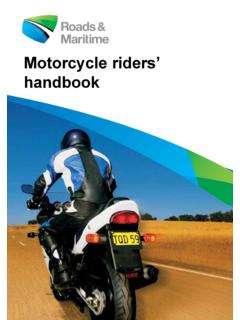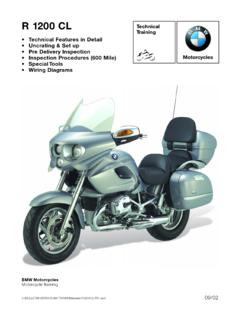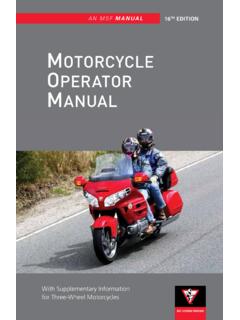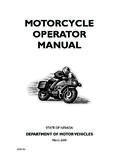Transcription of SUZUKI DR·Z400SM
1 $ SUZUKI DR z400sm OWNER'S MANUAL This owner's manual contains Important safety information Please read it carefully part No. 99011-29F92-03:'::-1 [;May. 2006 Ci:K:J EN I I Call1," 1"01""0111011 fo', Will IIIIICI Engine exhaust, some of Its constituents, and certalll product com ponents contain or emit chemicals known to the State of California to cause cancer and birth defects or other reproductive harm. This manual should be considered a permanent part of the motorcycle and should remain with the motorcycle when resold or otherwise transferred to a new owner or operator. The manual contains important safety information and instructions which should be read carefully before operating the motorcycle. IMPORTANT WARNING/CAUTION/NOTE Please read this manual and fol low its instructions carefully. To emphasize special information, the symbol A. and the words WARNING, CAUTION and NOTE Ilave special meanings. Pay spe cial attention to the messages highlighted by these signal words: Indicates a potential hazard that could result in death or injury.]
2 CAUTION Indicates a potential hazard that could result in motorcycle damage. NOTE: Indicates special informa lion to make maintenance easier or instructions clearer. WARNINGs and CAUTIONs are ;manged like this: The first part will describe a POTENTIAL HAZARD and WHAT CAN HAPPEN if you ignore the WARNING or CAU TION. FOREWORD Motorcycling is one of the most exhilarating sports and to ensure your riding enjoyment, you should become thoroughly familiar with the information presented in this Owner's Manual before riding the motorcycle. The proper care and maintenance that your motorcycle requires is outline in this manual. By follow ing these instructions explicitly you will ensure a long trouble-free operating life for your motorcycle. This motorcycle also conforms to the Environmental Protection Agency (EPA) and California Air Resource Board (CARB) emis sion regulations which apply to new motorcycles . The Proper adjustment of engine components is necessary for this motorcycle to comply with the EPA and CARB regulations.
3 Therefore, please fol low the maintenance instructions closely to ensure emission com pliance. Your authorized SUZUKI dealer has experienced techni cians that are trained to provide your machine with the best possi ble service with the right tools and equipment. The second part will describe HOW TO AVOID THE HAZARD. All inforrnililorl, i1111~>lr,i1H)">" ,,1111 10ljril"tls <lIHI ~'IJI'(i1l<:;llll)rl III 1,1111Cd III ttliS 111;11111<11 <l11~ 1);I~,(:d on the latest product "lIor rll<lllllli available at the time of publiCI tlon, Due to improvements or other changes, there may be some discrepancies between information in this manual and your motorcycle. SUZUKI reserves the right to make production changes at any time, without notice and without incurring any obligation to make the same or similar changes to vehicles previ ously built or sold. SUZUKI Motor Corporation believes in conservation and pro tection of Earth's natural resources.
4 To that end, we encourage every vehicle owner to recycle, trade in, or properly dis pose of, as appropriate, used motor oil, coolant and other fluids, batteries, and tires. SUZUKI MOTOR CORPORATION COPYRIGHT SUZUKI MOTOR CORPORATION 2006 TABLE OF CONTENTS I THE SPORT OF MOTORCYCLING I FUEL, ENGINE OIL ~ND COOLANT RECOMMENDATION CONTROLS, EQUIPMENT AND ADJUSTMENTS BREAK-IN AND INSPECTION BEFORE RIDING RIDING TIPS ACCESSORY USE AND MOTORCYCLE LOADING Ie INSPECTION AND MAINTENANCE TROUBLESHOOTING STORAGE PROCEDURE AND MOTORCYCLE CLEANING CONSUMER INFORMATION SPECIFICATIONS INDEX I I_ ~ ~ J III II I ~ II ] I II II ~ I THE SPORT OF MOTORCYCLING MOST ACCIDENTS CAN BE AVOIDED 1 2 IF YOU DON'T HAVE A HELMET: BUY A HELMET, AND WEAR IT EVERY TIME YOU RIDE 1-2 IF A COLLISION IS IMMINENT, DO SOMETHING! 1 3 PRACTICE AWAY FROM TRAFFIC 1 5 INSPECTION BEFORE RIDING 1 5 MOTORCYCLE SAFETY FOUNDATION'S "RIDING TIPS AND PRACTICE GUIDE" HANDBOOK BE STREET SMART 1 6 CONCLUSION 1 6 SPECIAL SITUATIONS REQUIRE SPECIAL CARE 1-3 KNOW YOUR LIMITS 1-4 BE EXTRA SAFETY CONSCIOUS ON BAD WEATHER DAYS 1-4 ACCESSORIES AND LOADING 1-5 CARRYING A PASSENGER, ON ROAD 1-5 (FOR OWNERS IN USA) 1-5 ADDITIONAL CONSIDERATION WHEN RIDING OFF HIGHWAY 1-6 1-1 'I'll F SPORT OF M ( rI'( )R( 'Y( 'I ~ I N( ; Your motorcycle and this owner's manual have been designed by people like you who enjoy motor cycling.))))
5 People become motorcy clists for many reasons. For starters, street riding is fun and invigorating. But no matter why you became a motorcyclist, or how experienced you are, you will eventually face some challenging situations. In preparing for these challenges, you will be fine-tuning your coordi nation, concentration, and atti tude. Learning the skills and strategies associated with motor cycling is the basis for safety par ticipating in this sport. Many motorcyclists find that as they become better riders, they also get more enjoyment from the free dom unique to motorcycling. Please remember: MOST ACCIDENTS CAN BE AVOIDED The most common type of motor cycle accident in the occurs when a car traveling towards a motorcycle turns left in front of the motorcycle. Is that because other drivers are out to get motorcy clists? No. Other drivers simply don't always notice motorcyclists. Ride defcll:,lvdy Wise motorcy clists use ;1 'ill;lI(~<JY of assumin~ they are Invlslhlc 10 other drivers even in broc1(J (jdylight.)))
6 Pay care ful attention fo other motorists especially af intersections because they may not be paying attention to you Select a lane position that gives you the besl view of others, and other motor ists the best view of you. Wear bright, reflective clothing. Put reflective strips on your helmet. IF YOU DON'T HAVE AHELMET BUY A HELMET, AND WEAR IT EVERY TIME YOU RIDE Most accidents occur within a few miles of home, and almost half occur at speeds of less than 30 mph. So even if you're just going on a quick errand, be prepared strap on your helmet before you take off. Helmets do not reduce essentia, vision or hearing. Generally, hel mets do not cause or intensify injury if you crash. Helmets simply help your skull protect your intelll gence, your memory, your pel sonality, and your life. Your eyesight is equally valuable Wearing suitable eye protectior can help keep your visior unblurred by the wind and saVE your eyes from airborne hazard: like bugs, dirt, or pebbles kickel up by tires.
7 IF ACOLLISION IS IMMINENT, DO SOMETHING! Many riders fear locking up their hrakes or haven't learned to :;werve to avoid an accident. Many inexperienced riders (and 100 many seasoned riders) use oilly their rear brake in an emer !J()ncy, resulting in unnecessary Illlpacts in some cases and lillnecessarily high impact speeds III other cases. Your rear brake 1:;1Il only provide about 30% of your motorcycle's potential stop I)lllg power. The front and rear hrakes can and should be used II )(Jether to maximize braking o"ectiveness. I xperienced motorcyclists learn 10 "cover" the front brake lever by lI<]htly resting a couple of fingers over the lever when riding in traffic Illld near intersections to give IIlnir reaction time a head start. Emergency stopping and swerv ing are techniques that you should practice and master before you find yourself in an emergency situation. The best place to prac tice such techniques is in a con trolled environment such as the Motorcycle Safety Foundation's (MSF) rider training courses.
8 The MSF's Motorcycle Rider Courses (fundamental techniques) and Experienced Rider Courses (advanced strategies) present hands-on instruction of the basic principles of motorcycling and a variety of accident-avoidance maneuvers. Even a seasoned motorcyclist can improved his or her riding skills, and pick up a few new skills, through these courses. Some insurance companies even offer discounts to course gradu ates. SPECIAL SITUATIONS REQUIRE SPECIAL CARE Of course, there are some times when full-force braking is not the correct technique. When the road surface is wet, loose, or rough, you should brake with care. When you're leaned over in a corner, avoid braking. Straighten up before braking. Better yet, slow down before entering the corner. 1-2 1-3 In these situations, the traction ilVilll<lble between your tires and Ille road surface is limited. Over braklllg when traction is limited will cause your tires to skid. possi bly resulting in loss of directional control or causing you and your motorcycle to fall over.
9 KNOW YOUR LIMITS Always ride within the boundaries of your own skills. Knowing these limits and staying within them will help you avoid accidents. A major cause of accidents involv ing only a motorcycle (and no cars) is going too fast through a turn. Before entering a turn, select an appropriately low cornering speed. Even on straight roads, ride at a speed that is appropriate for the traffic, visibility and road condi tions, your motorcycle, and your experience. Riding a motorcycle safely requires that your mental ano physical skills are fully part of the experience. You should not attempt to operate a motor vehi cle, especially one with two wheels, if you are tired or undel the influence of alcohol or othel drugs. Alcohol, illegal drugs, ancJ even some prescription and over the-counter drugs can cause drowsiness, loss of coordination. loss of balance, and especially the loss of good judgment. If you are tired or under the influence 01 alcohol or other drugs, PLEASE DO NOT RIDE your motorcycle.
10 BE EXTRA SAFETY-CONSCIOUS ON BAD WEATHER DAYS Riding on bad weather days. especially wet ones, requires extra caution. Braking distances increase on a rainy day. Stay of1 the painted surface marks, man hole covers. and greasy-appear ing areas, as they can be especially slippery. Use extra cau tion at railway crossings and 01 metal gratings and bridges. When it starts to rain, any oil or grease on ttle road rises to thesurface 01 tile water. Pullover and wait a fevv Illll1lJtes until this oil film wClshed away before ridin~ Whenever in doubt about roal conditions, slow down! PRACTICE AWAY FROM TRAFFIC Your riding skill and your mechan ical knowledge form the founda lion for safe riding practices. We ~;\lggest that you practice riding your motorcycle in a non-traffic ~"tuation until you are thoroughly liuniliar with your machine and its controls. Again, consider taking IH1e of the MSF's Rider Courses. I ven experts will be pleased with tilt) caliber of the information pre ~;nnted in these courses.






